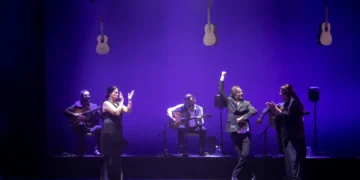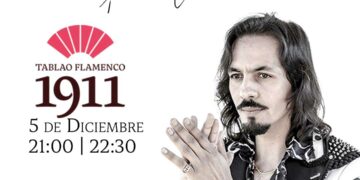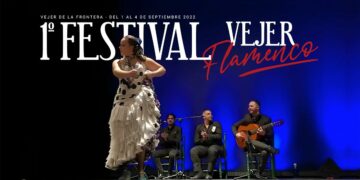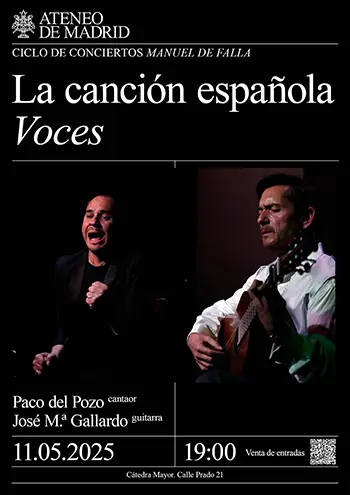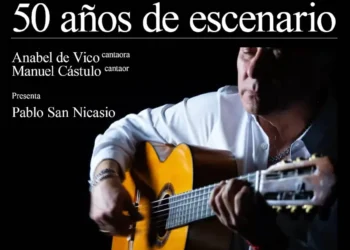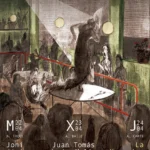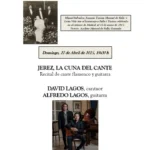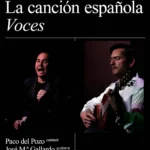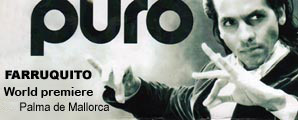
Farruquito “Puro” Thursday, July 24th, 2008. 10:00pm Palma Arena (Mallorca)
|
|
I go into the huge sports arena of Palma de Mallorca, and it’s suddenly deja vú. I remember about 25 years ago when Camarón gave a concert in a similar venue in downtown Madrid. We’re in Spain’s popular vacation spot, the Balearic Islands, but the audience is the same: entire gypsy families, many small children, young girls dressed as if for an audience with the King, elderly people, groups of local adolescents…here and there an English tourist in Bermuda shorts who has come for his or her “show flamenco” before returning to Manchester or Birmingham, never suspecting they are about to witness one of the most important flamenco dancers of our time. The ambience is reminiscent of the Jerez Fiesta de la Bulería, but without the drink coolers…and with many empty seats. The enormous Palma Arena had prepared for 2000 people, but a quick glance at curtain time looks more like 500 to 600 people in attendance for the world premiere of “Puro”, Farruquito’s new show and the dancer’s return to the stage. In an interview earlier in the day, Farruquito commented that he had chosen Palma for this historic debut because of his affection for the city, but it’s more than likely he wanted to test the waters in neutral flamenco territory before bringing his latest creation to mainland Spain. There are no programs, but we know in advance that the only dancer is going to be Juan Manuel Fernández Montoya, grandson of old Farruco, son of la Farruca. No family member will be on stage to back him up this time. The young man has come to put his cards on the table, all of them; the subtitle of the work is “Absolute Moment”, and the air is charged with expectation. It’s been at least two years since we’ve seen Farruquito on stage, and anything is possible, not even the audience’s reaction is guaranteed..
The show finally gets underway at half past ten with all the artists on stage. Excited shrieks, piano, palmas, guitar, percussion, voices, three giant screens and a smoke machine working overtime. It all feels like a rock concert, but with a certain religious air about it, thanks in part to the suggestive lighting and a designer wardrobe: everything is calculated to create a feeling of drama. Three excellent guitarists led by Antonio Rey, and seven powerful voices – I can just make out the wormen: María Vizárraga, Mara Rey and La Tana, and among the men I see Rubio de Pruna, Antonio Zúñiga (Villar), Juan José Amador Jr….Bernardo Parrilla on violín… An excellent audiovisual is projected between numbers…images of Farruquito dancing, at the beach, smiling, with his people… Manuel Molina revives his role of guitarist-reciter-Greek chorus with outstretched arms and looking heavenward: “Your grandfather said it, and so did your father, to dance siguiriyas it has to be in the blood”. When Farruquito comes in for a landing, audience excitement is at peak – people jump from folding chairs and run to and fro to get a better vantage point…there are excited shouts of approval and support. What about the dancing? What’s the show like? To be sure, Farruquito does not dance as he did before. He is dancing far better. A lot. The intense mystery of his artistic personality is better defined than before, more convincing and consistent, more mature. He has an entire catalogue of new moves that no longer depend on the bulerías outbursts that had begun to feel repetitious and in general, he has settled down and administers his considerable resources with intelligence. The show itself is the best the dancer has presented to date, in fact one of the best I’ve seen in general. Oddly enough, the family without Farruquito falls a little flat – recent shows have seemed to indicate a certain decline. But Farruquito without the family turns out to be quite self-sufficient. Over the hour and a half of the show, the dancer became more at ease, more confident, you could sense his extreme feeling of joy and fulfillment. The back-up musicians, each and every one of them, including the piano, violin and percussion, but most especially the singers, are superb, and Farruquito administers these first-class ingredients well; no one today dances so directly to the singing, and other major figures, with their well-rehearsed arrangements and lack of spontaneity, pale sadly by comparison. The grandfather created an aesthetic, and he knew how to transmit it to Farruquito: “…he’s looking down on you from above” intones Manuel Molina, and you want to believe it. Excellence in the details. In the end, the entire group appears dressed in pristine white, seeming to represent a spiritual and artistic rebirth, and the women singers in chilabas look like high priestesses come to bless the event with their raw voices. Farruquito leaves the stage ripping off his shirt, and the buttons go flying like white buckshot. |




